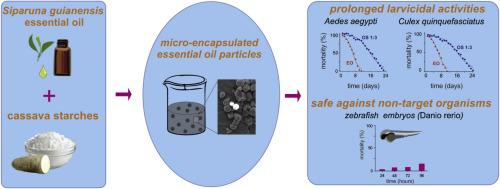Industrial Crops and Products ( IF 5.6 ) Pub Date : 2021-02-04 , DOI: 10.1016/j.indcrop.2021.113289 Wellington S. Moura , Eugênio E. Oliveira , Khalid Haddi , Roberto F.T. Corrêa , Tathyana B. Piau , Diego S. Moura , Suetônio F. Santos , Cesar K. Grisolia , Bergmann M. Ribeiro , Raimundo Wagner S. Aguiar

|
Due to the production facilities and great functionalities, the starch extracted from Cassava plants' (Manihot esculenta Crantz) roots is one of the most abundant and inexpensive raw materials used in food- and non-food industries. The utilization of starches to encapsulate plant essential oils is a relevant advance in the control of insect pests, including mosquitoes that transmit human diseases. The starch-based microencapsulation of essential oils reduces the degradation and volatilization of active components, providing more sustainable and environmentally friendly activities. Here, we investigated the potential of cassava-based starch microparticle preparations containing the essential oil of a Neotropical plant (Siparuna guianensis Aublet) to control larvae of Aedes aegypti and Culex quinquefasciatus. Moreover, the selectivity of the most efficient microparticles preparation was evaluated on zebrafish embryos (Danio rerio), an aquatic non-target organism. The characterization of encapsulated microparticles was achieved by using scanning electron microscopy (SEM), infrared spectroscopy with Fourier transform (FTIR), and thermogravimetric analysis (TGA). Our results revealed an encapsulation efficiency of 82.8 % to 95.3 %, with an average particle diameter of 8.56 μm. Cassava starch microencapsulation reduced the essential oil degradation and enhanced (up to 8 days) the persistent lethal activities (over 50 %) against both species' mosquito larvae compared to the pure essential oil. Furthermore, the exposure of aquatic non-target organisms (embryos of D. rerio) revealed these microparticles' adequate selectivity. Collectively, our findings demonstrate that cassava starch-based microparticles exhibit promising functionality as carriers for essential oils with mosquitocidal activities.
中文翻译:

木薯淀粉基精油微粒制剂:蚊子控制功能和针对非目标生物的选择性
由于生产设备和功能强大,从木薯植物(Manihot esculenta Crantz)的根中提取的淀粉是用于食品和非食品行业的最丰富,最便宜的原料之一。利用淀粉来封装植物精油是控制害虫(包括传播人类疾病的蚊子)方面的重要进展。基于淀粉的精油微囊化可减少活性成分的降解和挥发,从而提供更可持续和环保的活动。在这里,我们研究了含有新热带植物(Siparuna guianensis Aublet)精油的基于木薯的淀粉微粒制剂控制幼虫的潜力。埃及伊蚊和库蚊。此外,在斑马鱼胚胎上评估了最有效的微粒制剂的选择性(Danio rerio),一种非目标水生生物。通过使用扫描电子显微镜(SEM),具有傅里叶变换的红外光谱(FTIR)和热重分析(TGA),可以实现对封装微粒的表征。我们的结果表明,包封率为82.8%至95.3%,平均粒径为8.56μm。与纯精油相比,木薯淀粉微囊化减少了精油的降解,并提高了(长达8天)针对这两个物种的蚊虫幼虫的持续致死活性(超过50%)。此外,水生非靶标生物(D. rerio的胚)的暴露)表明这些微粒具有足够的选择性。总的来说,我们的研究结果表明,基于木薯淀粉的微粒作为具有灭蚊活性的精油的载体表现出有希望的功能。











































 京公网安备 11010802027423号
京公网安备 11010802027423号